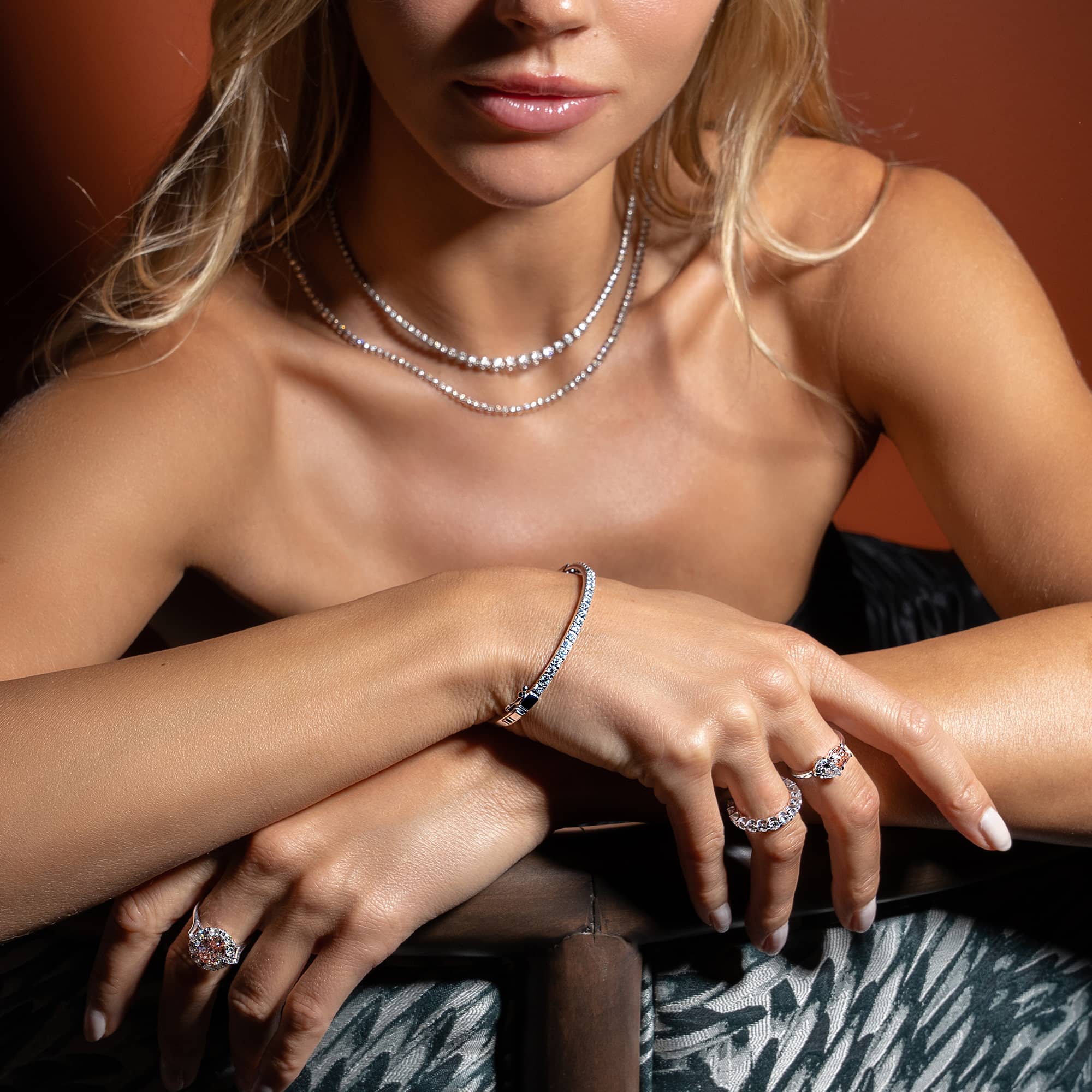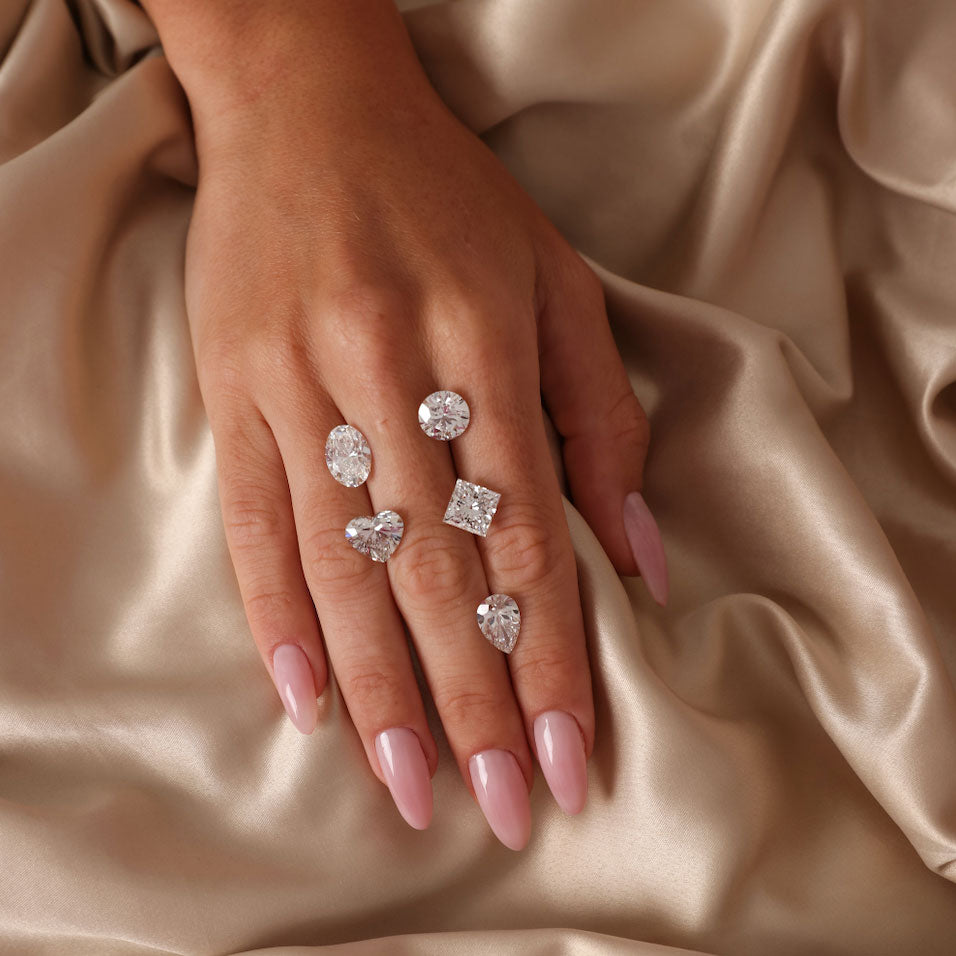The 4Cs: Your Essential Guide to Diamonds
Whether it’s an anniversary present, a treat-yourself gift, or the life-changing engagement ring, knowing what to look for in a diamond can make all the difference between pretty and breathtaking. You don’t need years of experience or a jeweler’s loupe to spot a quality diamond—all you need to know is what to ask.
It all comes down to cut, color, carat, and clarity, known in the industry as “The 4 Cs”. Though it seems straightforward, there is a world of nuance and knowledge that goes into spotting the perfect stone.
We’ve put together an easy-to-follow primer on these essential elements, to ensure you’ll know what you’re looking for next time you pick out a diamond.
The Cut
The cut grade scale ranges from excellent (the highest grade) to poor. Diamond’s cut grade refers most of all to its proportions. Diamond’s cut directly affects its interaction with light and has three primary effects on its appearance: brilliance, fire and scintillation. These characteristics affect the diamond beauty and overall appearance.
It’s the first impression a diamond makes but far from the only criteria you should take into account. While all diamonds start out as dull rounded roughs, almost indistinguishable from any other crystalline rock, the diamond’s cut is what gives it its personality, and, most crucially, its brilliance.
The first thing to know is that a “cut” isn’t the same as a shape, but rather the arrangement of its facets. Regardless of its shape, when a diamond’s cut is done with exact precision, light will enter and exit through the same surface—this is what gives a diamond its sparkle. While there are countless unique shapes, most diamonds will be cut in one of three primary styles:
- Brilliant—a mix of triangular and kite-shaped facets
- Step—composed of only rectangular facets
-
Mixed—a combination of brilliant and step cuts
Once a diamond rough has been cut, it is then graded on three factors: scintillation (brilliance), pattern (facet arrangement) and contrast (the interplay between the stone’s light and dark areas) and a few secondary factors like weight ratio, proportions, durability, polish, and symmetry. A cut diamond will then be graded in one of three ways:
- Excellent – Highly brilliant and evenly patterned
- Very good - Highly brilliant but perhaps some darker spots
- Good - Somewhat less scintillating and perhaps more dark areas than very good.
- Fair & poor - Low brilliance and low degree of scintillation.
Grwn’s diamonds are cut and polished the traditional way, by experienced artisans in a zero-emission foundry. From the diamond seed to the final setting, we keep a close eye on every step of the process to ensure we are crafting only the highest grade diamonds.
The Color
The next most important element in a diamond is the color. It is a key factor in diamond evaluation. Color grade ranges from D for colorless diamond (white) to Z that reflects light color shade of yellow or brown. The whiter the diamond is the rarer it becomes and the higher its value.
In diamonds, “color” is really more a reference to the absence of color. Most diamonds’ colors range from an icy colorless white to a light yellow tint. However, naturally occurring greens, blues and, the exceptionally rare pink, are also found, and can be duplicated in the lab. Without a trained eye or the proper inspection equipment, it's very difficult to tell the difference from one color grade to another color grade. For this reason, it’s important to compare diamonds side by side.
Starting from “D”, which denotes a completely colorless stone, the color grading scale follows the alphabet downward, with colorless and near colorless diamonds appearing sitting in a range of D through J. Beyond J, subtle amounts of pale yellow begin to show through.

Aside from the aforementioned pink shade, completely colorless diamonds are the rarest, and therefore the most expensive. Yellow-tinted diamonds, on the other hand, are much more common and therefore the least expensive.
A diamond’s color will impact its overall appearance. Grwn offers only sustainably produced colorless and near colorless stones ranging from D-J on the color scale.
The Clarity
The diamond clarity grade is determined after examination for blemishes under X10 magnification. ALmost every diamond contains some kind of inclusion, this is the nature fingerprint which turns every diamond to one of a kind. The blemishes nature, position, number and their effect of the diamond overall appearance will determine the clarity grade. The clarity grade ranges from FLAWLESS for a pure and blemish free diamond, to I3. The cleaner the diamond is, the rarer it becomes, and the higher its value.
While a diamond’s cut and color primarily affect its appearance, the third C, clarity, mainly affects its rarity and, therefore, value. Simply put, a diamond’s clarity refers to the tiny, sometimes even microscopic, imperfections (known in the industry as “inclusions”) within the structure of a diamond. Without an experienced eye and magnification tools, these markings are often unnoticeable.
In natural diamonds, these internal imperfections are naturally occurring, created within the intense heat and pressure during the formation of the diamond. Diamond inclusions are graded at 8 different levels, beginning at “Flawless”, and decreasing to “Included 3”, which is the lowest level of clarity. At low levels, imperfections have little visible effect, most often just affecting the way light passes through the stone. At higher levels, these obstructions and refractions can create a “cloudy” look within the diamond.
When assigning a grade to a diamond’s clarity, 5 factors are considered:
- The size of imperfections
- The number of imperfections
- Their position within the diamond
- how they impact its durability
- The contrast between the imperfections and the diamond itself

Unlike lab-grown diamonds created through the “High Pressure, High Temperature” (HPHT) process, Grwn’s cleaner “Chemical Vapor Deposition” (CVD) process creates a more perfect rough from which our gems are cut. We offer only diamonds with a clarity rating of very very slightly included (VS2) or above, which is ensured through meticulous lab work by knowledgeable gemologists. We go beyond eye-assessed clarity, using 10x magnification for a deeper look into your diamond’s clarity.
The Carat
Perhaps the most well-known “C”, yet the least understood is the carat. Contrary to popular belief, a diamond’s carat is a reference to its weight, not its size. Carat is the acceptable weight unit in the diamond industry. 1 carat is equivalent to 0.2 grams, and for maximum accuracy it is divided into 100 points.
1 ct = 100 points = 0.2 grams,
Half a carat = 50 points, etc.
Given the fact that the cut and shape will have a major influence on the weight of a diamond, it’s important to remember that bigger isn’t always better. In other words, a higher carat diamond in a poorer cut will appear smaller than a well-cut diamond of lower carat.

When it comes to the appearance and quality of a diamond, the carat is arguably the least important of the four Cs to take into consideration, which, by and large, mostly contributes to a stone’s expense. When visualizing carats, keep in mind that one carat is equal to 0.2 grams—roughly the weight of a paperclip.
Grwn’s cutting-edge technology allows us to offer diamonds from less than a carat to over 5 carats—which are then cut and polished by experienced artisans who will maximize the diamond’s beauty and weight.
Why the 4 Cs Matter
The 4 C’s are your roadmap to understanding the elements of a quality diamond. Before the 4 Cs standard was adopted as the international standard, there was little way to gauge the value of a stone. Individual diamond merchants could sell their diamonds based on personal bias or amateur grading., meaning that consumers were often paying more for an inferior stone. With a basic understanding of the 4Cs and diamond certification, you can know what to look for and what questions to ask when it comes to determining the value of a diamond.
The Unofficial “5th C”
Our 5th C is carbon neutral! Grwn created diamonds are made by utilizing hydropower, a clean and renewable source of energy, to convert greenhouse gas in our zero-emissions foundry. Though years of experience have made us unmatched when it comes to cut, color, clarity, and carat, it’s our (and your) passion for creating a cleaner, more sustainable plant that has led our commitment to a net-zero carbon footprint. Our diamonds are more than precious stones, they’re brilliant reminders of the possibility of a more ethical and sustainable future within the luxury jewelry industry, and beyond.

FOX5 NEWS REPORTS
Grwn Diamonds released a study on the best and worst states for marriage. The study took a look at data from the CDC and the Census Bureau to help make their final decision.
COLLABORATIONS

















